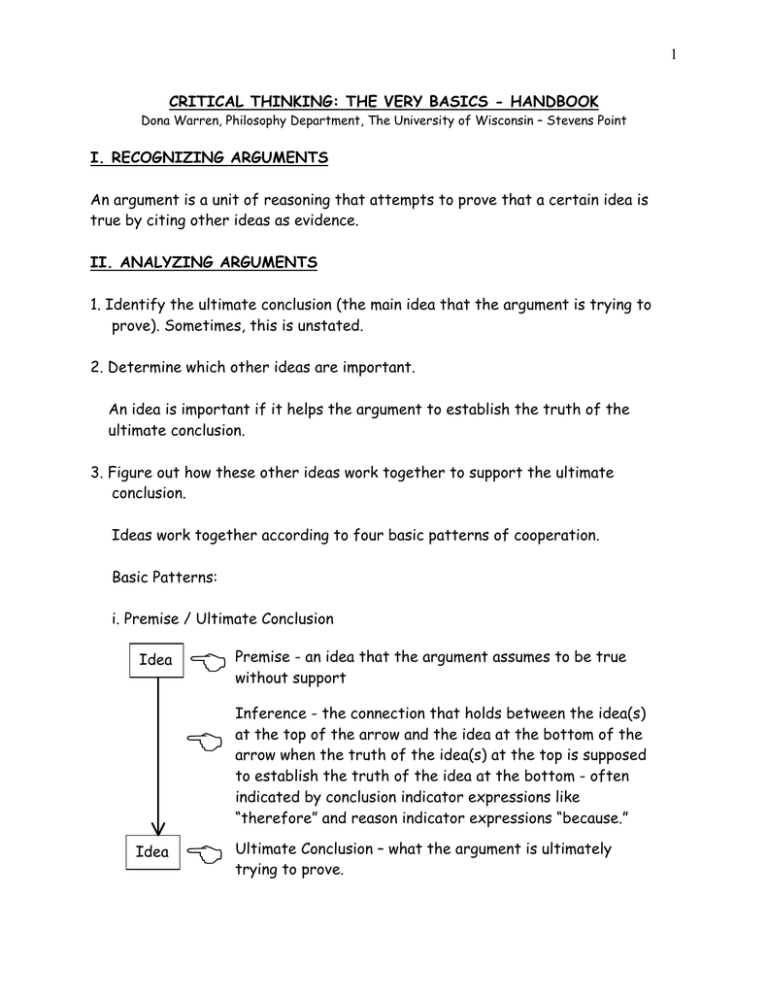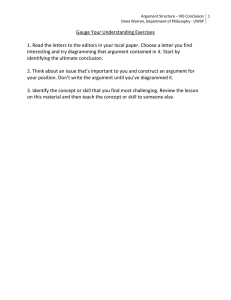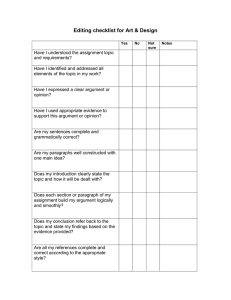1 An argument is a unit of reasoning that attempts to... true by citing other ideas as evidence.
advertisement

1 CRITICAL THINKING: THE VERY BASICS - HANDBOOK Dona Warren, Philosophy Department, The University of Wisconsin – Stevens Point I. RECOGNIZING ARGUMENTS An argument is a unit of reasoning that attempts to prove that a certain idea is true by citing other ideas as evidence. II. ANALYZING ARGUMENTS 1. Identify the ultimate conclusion (the main idea that the argument is trying to prove). Sometimes, this is unstated. 2. Determine which other ideas are important. An idea is important if it helps the argument to establish the truth of the ultimate conclusion. 3. Figure out how these other ideas work together to support the ultimate conclusion. Ideas work together according to four basic patterns of cooperation. Basic Patterns: i. Premise / Ultimate Conclusion Idea % % Idea % Premise - an idea that the argument assumes to be true without support Inference - the connection that holds between the idea(s) at the top of the arrow and the idea at the bottom of the arrow when the truth of the idea(s) at the top is supposed to establish the truth of the idea at the bottom - often indicated by conclusion indicator expressions like “therefore” and reason indicator expressions “because.” Ultimate Conclusion – what the argument is ultimately trying to prove. 2 ii. Subconclusions Idea % Idea Subconclusion – an intermediate idea on the way from the premises to the ultimate conclusion Idea iii. Dependent Reasons + Idea % Idea Idea Dependent Reasons – neither idea can support the conclusion alone but together they can support the conclusion iv. Independent Reasons Idea Idea % Idea Independent Reasons – each idea can support the conclusion on its own This gives us independent lines of reasoning. Combinations e.g. Id. Id. Id. + Id. Id. Id. Id. Id. Id. Id. Id. Id. + + Id. Id. 3 III. EVALUATING ARGUMENTS • • A good argument establishes the truth of its ultimate conclusion and gives its audience good reason to think that the ultimate conclusion is true. A bad argument either doesn’t establish the truth of its ultimate conclusion or else doesn’t give its audience good reason to think that the ultimate conclusion is true. 1. Appreciate the general structure of the argument • • A good argument must have at least one good line of reasoning. A good line of reasoning must have all good premises and all good inferences. 2. Evaluate the premises When evaluating a premise, we should ask ourselves three questions: 1) “Is this premise true?” 2) “Would most members of the argument’s audience, including people who don’t already believe the ultimate conclusion, believe this premise?” and 3) “Does the argument’s audience have good reason to believe this premise?” If the answer to one of these questions is “no,” the premise is bad. If the answer to all three questions is “yes,” then the premise is good. 3. Evaluate the inferences Reason (R) The inference is valid = If R were true then C would have to be true as well. The inference is good = If R were true then C would probably be true as well. Conclusion (C) The inference is bad = Even if R were true, C could very easily be false. 4 The Bob Method: Bob is a perfectly gullible but perfectly rational person. We tell Bob to believe R and then ask ourselves “In light of his belief in R, how likely is Bob to believe C?” • If Bob is compelled to believe C, then the inference between R and C is valid. • If Bob is inclined but not compelled to believe C, then the inference between R and C is good. • If Bob is not at all inclined to believe C, then the inference between R and C is bad. 4. Assess the argument the argument as a whole • • • • We evaluate the argument in light of what we’ve learned about the argument’s structure, premises, and inferences. If we think that an argument is bad, we should form no opinion about the ultimate conclusion on that basis. If we think that an argument is good, we should be inclined to believe the ultimate conclusion on that basis. If we’re faced with reasonably good arguments for competing positions, we should believe the position supported by the strongest arguments. IV. CONSTRUCTING ARGUMENTS 1. Decide upon the Ultimate Conclusion i. ii. iii. iv. Ask a question. Consider various answers. Research answers. Formulate an answer. 2. Construct the Chain of Reasoning i. Think of reasons to believe the answer. ii. Diagram an argument on the basis of these reasons. iii. Evaluate the inferences. – Repair weak inferences by adding dependent reasons. 5 iv. Evaluate the premises. – Repair false premises by changing them. – Repair premises that might not be believed by transforming them into subconclusions. v. Repeat until the argument is good. • • • If the argument can’t be repaired, construct another argument for the conclusion. If no argument for that conclusion works, change the conclusion by opting for another answer to the original question. If no answer to that question can be supported by a good argument, reconsider the question. (Does it assume a falsehood?) 3. Communicate the Argument Write a passage containing the argument. Ensure that your passage makes the argument easy for your reader to analyze.





